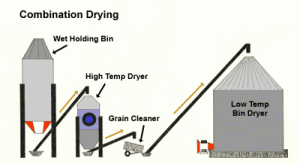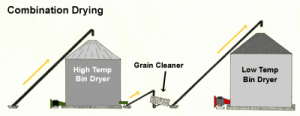 Combination drying uses the best features of high temperature and ambient air/low temperature drying, resulting in the most energy-efficient drying process. In this method, grain is dried to 20-22 percent moisture or less (more in early fall) with a high temperature dryer and then transferred while still hot to a low temperature dryer to finish the drying process. This method can be used with any type of high-temperature dryer – continuous-flow, batch or High temperature bin dryer. Ambient air/low temperature drying bins require fans large enough to complete the drying, typically 1 to 1.5 cfm per bushel depending on location. Cleaning the grain of small particulates will improve airflow during the low-temperature drying process.
Combination drying uses the best features of high temperature and ambient air/low temperature drying, resulting in the most energy-efficient drying process. In this method, grain is dried to 20-22 percent moisture or less (more in early fall) with a high temperature dryer and then transferred while still hot to a low temperature dryer to finish the drying process. This method can be used with any type of high-temperature dryer – continuous-flow, batch or High temperature bin dryer. Ambient air/low temperature drying bins require fans large enough to complete the drying, typically 1 to 1.5 cfm per bushel depending on location. Cleaning the grain of small particulates will improve airflow during the low-temperature drying process.
 This method uses more electricity but less gas energy than high temperature drying alone. Energy used in combination drying is typically 75 percent gas and 25 percent electricity versus 98 percent gas and 2 percent electricity used in high-temperature drying. If the grain is to be stored in a high temperature batch bin dryer, it can be dried to about 20 percent moisture, whereupon the heater can be shut off and the drying finished with unheated air.
This method uses more electricity but less gas energy than high temperature drying alone. Energy used in combination drying is typically 75 percent gas and 25 percent electricity versus 98 percent gas and 2 percent electricity used in high-temperature drying. If the grain is to be stored in a high temperature batch bin dryer, it can be dried to about 20 percent moisture, whereupon the heater can be shut off and the drying finished with unheated air.
If you have questions about the information on this site, please contact
Scott Sanford, Distinguished Outreach Specialist, University of Wisconsin, sasanford@wisc.edu.



